The VW GTI isn’t a muscle car, but it was inspired by one – the 1964 Pontiac GTO.
That car is considered by many to be the first muscle car, but what really made it significant – and copied – was that it was the first affordable high-performance car.
Prior to the GTO, most fast cars were expensive cars.
You generally had to be affluent – and thus, established (which almost always means older) to drive one. 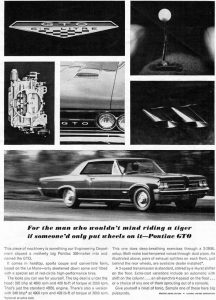
The GTO brought performance to the masses – particularly the young masses. Here was a V8 brawler that could out-accelerate the Ferraris of its time – but which a kid just out of high school or college could plausibly make the payments on.
It was basically a Tempest – Pontiac’s lightweight economy car of the era – fitted with a high-compression V8 and heavy duty underpinnings but without power windows, AC and leather seats – unless you added them.
This kept the GTO’s price as low as its 0-60 time.
But the GTO – and its emulators – didn’t survive the ‘70s, chiefly due to rising gas prices and the rising cost to insure any high-powered car, if you weren’t “established.”
The need for an affordable performance car had returned.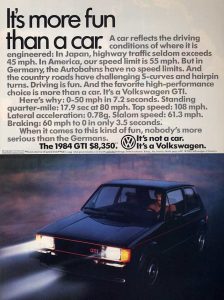
VW answered the call.
In 1984 the first GTI appeared.
Like the GTO, it was based on a transportation appliance – in this case, the Rabbit.
Same basic idea that Pontiac had – just expressed in front-wheel-drive and four-cylinder form this time around. But exactly like the GTO in that it was quick, fun and most of all – affordable.
The GTO is long gone but the GTI thrives – possibly because in addition to all of the above, the VW was – and still is – practical.
It can be a family car as well as a performance car. There’s horsepower – and room.
It’s an economical car, too.
The GTI is a hotted-up version of VW’s popular Golf five-door hatchback.
The hotting up centering around the latter-day equivalent of a high-compression compression 389 V8 with three carburetors , a four-speed close-ratio manual transmission, Hurst mags and splitter exhaust tips.
Well, you won’t get that – but you will get this:
A highly pressurized 2.0 liter four – paired up with a six-speed manual transmission. Or an optional seven-speed automated manual transmission. Limited slip differential. Eighteen-inch wheels – and a pair of gattling gun exhaust tips.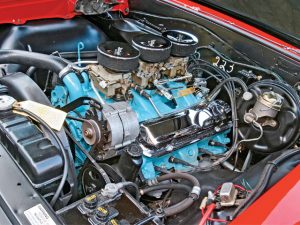
Plus 32 MPG on the highway – about twice the mileage delivered by a V8 GTO.
Base price is $27,595.
A top-of-the-line Autobahn trim comes with all of the essentials plus an adaptive suspension, 8-inch LCD touchscreen, climate control AC and a very nice Fender surround sound audio system (much better than the GTO’s AM radio with “reverb”) stickers for $35,995.
Emulators include the Mini Cooper S, Hyundai Veloster turbo and Honda Civic Si.
The Rabbit name returns – as a trim option. It features retro-Rabbit exterior badging, special paint schemes and unique 18-inch black chrome wheels. Rabbits also come standard with push-button ignition and upgraded LED headlights.
All 2019 GTIs get upgraded brakes and a limited slip axle.
A new seven-speed automated manual transmission replaces the previously optional six-speed automatic.
Go fast – without going broke.
Lots of leg, head – and cargo room.
Doesn’t take up much room.
“It wasn’t me” appearance.
Three-door version isn’t for sale here.
High-performance 40-series “summer” tires are only available with the highest-price Autobahn trim ($35,995 to start).
You must use premium unleaded to get the full advertised horsepower.
If you buy the automatic transmission, you’ll get ASS – Automated Stop/Start.
Under The Hood
Unlike the Golf on which it’s based, the GTI comes standard with a 2.0 liter, 228 horsepower engine rather than a 1.4 liter 147 hp engine.
Which will get you to 60 in 5.9 seconds – vs. about 8 seconds for the Golf.
Interestingly, this big difference in power – and speed – does not come at the expense of mileage.
Not much expense, anyhow.
The new Golf – which is much less powerful this year than last year – rates 29 city, 37 highway.
The new GTI – which is 8 horsepower stronger than it was last year – rates 24 city, 32 highway with the standard six-speed manual. That’s a 5 MPG sacrifice in exchange for an 81 horsepower upgrade and more than two seconds off the 0-60 time.
Even if gas cost $4 a gallon, driving the GTI wouldn’t break the bank vs. driving (much more slowly) the new Golf.
Another interesting thing:
The GTI’s optional seven-speed automated manual doesn’t change the MPG equation very much vs. the shift-it-yourself six-speed manual. It just shifts it around some.
With the auto-manual, city mileage goes up by 1 to 25 MPG while highway mileage goes down by 1 MPG, to 31.
This is a kind of reversion to form. In the past, the manual-equipped version of a given car would usually be the more fuel-efficient version – assuming driven by someone who knew how to drive a manual-equipped car – because of the direct, mechanical connection between the engine, transmission – and the road.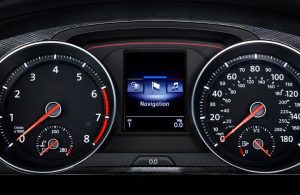
The slippage which enables an automatic-equipped car to remain in gear while not moving also meant an efficiency loss – and that reflected in a mileage loss.
In recent years, automatic transmission slippage has been decreased via lock-up torque converters – which establish a mechanical connection between the engine, transmission and the road . . . once the car is rolling (you still have to have a little slippage when the car isn’t rolling – or the car would stall out just like a manual car left it in gear with the clutch out).
Modern automatics are also typically programmed to upshift in such a way as to maximize the MPGs.
In this case, the automatic is programmed to maximize acceleration.
Which, for the record, is tops in its class.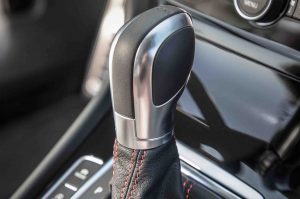
The Mini Cooper S – which is only packing 189 hp – takes 6.4 seconds to get to 60. The JCW Works version (which packs the same 228 hp punch as the GTI) matches the GTI’s acceleration run – but its price ($31,900 to start) effectively puts it an another class.
The one for “established” performance buyers.
There was the Ford Focus RS – but it’s kaput. Cancelled. RIP. In the history books, along with the GTO.
Along with the MazdaSpeed3 – the speedy version of the Mazda3. Also RIP.
There is the just-updated Soobie WRX – which is packing more under its hood than the GTI – 268 hp from its 2.0 liter turbo’d four. But it’s a dead heat on the 0-60 score card.
It’s also AWD – and so a different kind of performance car.
The most credible threat to the GTI is probably the Hyundai Veloster turbo – which starts just under $23k, making it even more affordable than the VW.
But, the Veloster is a three-door-only deal – with back seats only Dick Cheney could love.
These emulators all have their merits. But the GTI encompasses them all.
The GTI is not only quicker than its price-comparable competitors, it is quicker than the car which inspired it.
A 1964 GTO powered by a 6.5 liter (389 cubic inch) V8 engine making a rated (but exaggerated by the measuring methods of the era) 325 horsepower took 7.7 seconds to get to 60.
See here, if you disbelieve.
Part of the problem – back then – was of course traction. The GTO’s big V8 had to channel its power through very small – very narrow – tires. Those 14×6 Hurst mags looked great – and were great for frying the tires. But traction was terrible and if you haven’t got that, you’re not getting going.
The GTI has fantastic traction.
In part because it’s front-wheel-drive. The rear-drive GTO was light in the rear – compounding the traction deficit of tires skinnier than what you’d get with a new Prius.
It – the VW – practically bunches up the pavement like a cat clawing the carpet. Eighteen-inch wheels make a difference. The poor old GTO would probably have made it to 60 in six seconds if it had been able to hook up the power under its hood.
There is another, more important difference.
Unlike the GTO – which was a brutal car – the GTI is an easygoing car. The ride doesn’t beat you up and the standard heated seats – a feature no classic GTO offered – are easy on your back. The manual version’s clutch take-up isn’t abrupt, which makes it pleasant to drive when you’re stuck in traffic and having to stop – and start – constantly.
The full bloom of the 2.0 liter engine’s 258 ft.-lbs. of torque is on hand almost immediately – peak output occurs at 1,500 RPM. And the horsepower peak is reached at just 4,700 RPM.
This latter number is about 1,500 RPM lower than is typical for high-powered fours and probably accounts for the GTI’s impressively quick 0-60 run. Less time spent revving means less time waiting in between shifts. It also means excellent performance everywhere, anytime.
The VW is never lacking for motive power, either down low – or up high – or in between.
Like the Golf, the GTI also benefits from excellent visibility to the rear and sides because of its boxier rather than hunched-over posture. Its very tight exterior dimensions – the whole enchilada is just 168 inches long, bumper to bumper – make it exceptionally agreeable in close-quarters driving.
It fits in parking spots off-limits to others – including cars like the WRX (180.9 inches long, almost a full foot longer).
The GTI is very compact – on the outside.
But it is also very roomy – on the inside.
Especially with regard to headroom in both rows – which is due to its tall and boxy roofline.
Up front, there’s 38.4 inches of headroom. And in back, 38.1 inches – almost no loss of headroom. Contrast with swoopier-roofed things like the Hyundai Veloster. It has only 36.9 inches of headroom up front – and 35.9 inches in its second row.
That’ll put a crick in your neck.
Assuming you can get back there at all.
The Veloster is a three-door so you’ll have to walk around to the passenger side, where the one rear door is situated, then duck (the Hyundai’s roofline is 55.1 inches off the ground vs. 58.2 for the VW) and scrunch (backseat legroom in the Veloster is 34.1 inches; the VW’s got 35.6 inches of legroom).
The Veloster is a fun car, but it’s implausible as a family car.
The VW’s taller – and flatter – roofline also opens up an equally impressive amount of cargo room. With the back seats folded, the GTI has 52.7 cubic feet of cargo space – significantly more than the Veloster’s 44.5 cubic feet. And – again – it’s more useable space because it’s more accessible space.
The box shaped opening also fits box-shaped stuff more agreeably.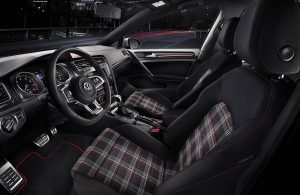
With the back seats up, you’ve still got 22.8 cubic feet of cargo space available – which is much more “trunk” than any classic-era GTO could boast of and by today’s standards, most classic-era GTOs would be considered full-size cars.
Unlike the GTO – which was affordable in part because it was spartan – the GTI isn’t.
Though you can get tartan-patterned cloth seats, if you like.
All trims come with the previously mentioned heated seats standard, as well as a leather-wrapped sport steering wheel, ambient interior mood lighting, a 6.5 inch touchscreen and both Android Auto and Apple Car Play.
SE trims are available with the previously mentioned adaptive suspension, which makes the GTI even more enjoyable to drive either full-tilt or in stop-and-go traffic. You’ll also get the upgraded Fender eight-speaker audio rig.
VW does not – yet – offer the digital cockpit available in other models, including the all-wheel-drive Golf R. But analog gauges work perfectly well – and they help keep the GTI’s price tag affordable.
The Rest
VW sells a three-door GTI in Europe but won’t be selling that version here. This is probably sound policy because the five-door hatchback layout helps the GTI keep a low profile. People who know fast cars know that it is – but as far as the rest of the world is concerned it’s just another Golf.
This is good for getting away with using the GTI.
One nit:
If you want the maximum handling grip offered by the “summer” tire package, you’ll have to buy those tires over the counter . . . unless you buy an Autobahn GTI. It’s the only trim VW will sell you with the grippiest tires installed at the factory.
This is a shame, but at least easily correctable.
The GTI’s rivals have kidney-killing rides or torturous back seats or just cost too much – problems that aren’t easily correctable.
The Bottom Line
If the GTO had made as much sense as the GTI, it might still be around.
. . .
Got a question about cars – or anything else? Click on the “ask Eric” link and send ’em in!
If you like what you’ve found here please consider supporting EPautos.
We depend on you to keep the wheels turning!
Our donate button is here.
If you prefer not to use PayPal, our mailing address is:
EPautos
721 Hummingbird Lane SE
Copper Hill, VA 24079
PS: Get an EPautos magnet (pictured below) in return for a $20 or more one-time donation or a $5 or more monthly recurring donation. (Please be sure to tell us you want a sticker – and also, provide an address, so we know where to mail the thing!)
My latest eBook is also available for your favorite price – free! Click here. 


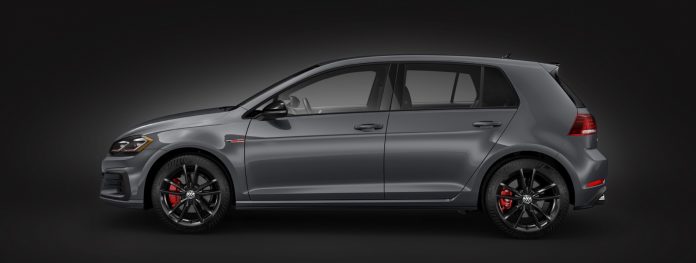















If the 268 hp isn’t enough for you, don’t forget that you can get the ECU reprogrammed by companies like APR. I have a 2017 VW CC which comes with a 200hp 2.0L turbo stock. With just a stage one tune (about $700), that goes up to 268hp, and that’s on 100% stock equipment. Add to that an APR cold air intake (about $300), and a stage one tune on the DSG transmission (another $700), and it’s up to 275hp, with 296 ft lbs of torque! My CC now does 0-60 in 5.7 seconds, and the speed limiter is removed (unknown top speed now, I would estimate 150-160mph). But it also still gets 30mpg if driven conservatively.
But here’s the best part. The APR stage 1 tune still allows the car to pass CA emission requirements!
I don’t know how much more APR can pull out of this GTI engine, but I would imagine it would be at least another 30 hp.
Eric,
Would this car be one of the few new ones that would fall in line with the level of tech from say the early 2000’s? ASS is the only thing I saw mentioned and that is limited to the automatic version. Is it devoid of all the latest nanny state items like lane assist, adaptive cruise control, etc.? It even still has gauges and not an lcd screen “cluster”.
I had been leaning towards one of the reintroduced TDI Sportwagens but now I’m thinking GTI. The GTI just seems more fun and still has a lot of cargo room. The tradeoff being it doesn’t get the mileage the TDI does but I can live with that. And it’s not like it’s a huge penalty. The diesel can also cause issues in colder climates too. I prob. would’ve have trouble early this winter with a TDI when the temps dipped below -30.
Hi c_dub,
It is available with forward collision warning with automatic emergency braking, blind-spot monitoring and rear cross-traffic alert – but these “features” are part of the optional Driver Assistance package. Yea!
So, yes – grab one before they ruin the fun.
Sweet! Thanks for the info Eric.
Morning, c_dub!
You bet; if you are seriously interested in the car, I’d snatch one up before VW decides to makes these “features” standard for 2020…
Yeah I hear you Eric. I did go to their website later and try the build your own feature. It looks like the driver assistance package is standard on everything but the S. So it wouldn’t surprise me if they did that next year on all the models. Or just get rid of the S altogether.
OK, Eric, If I buy one, do I have a way to credit you for the sale?
It is a 2019 GTI rabbit with manual in Wisconsin.
Do you have a reference so that one can give your site your due for reviewing this stuff?
Had a 2016 Autobahn GTI automatic for a year. Loved it. Traded up to a Chevy SS sedan b/c I missed the V8 rumble (and it’s a more comfortable, roomier car than the GTI, minus the huge hatchback/rear area).
I scanned the other posts and will add a few comments:
Gas mileage was underrated by the EPA. I was easily able to get 36mpg all day long at 70mph on the interstate. It could get even better (close to 40mpg) at 60mph on backroads and state highways. The handling is so good that you don’t have to slow down for most corners, so you don’t have to speed back up coming out of them. It is simultaneously both a sedate and fun way to go from A to B.
The exact same engine is rated at 240 hp in Europe (vs. 228, formerly 220) here in the States. Most dyno runs with stock setups suggest the US rating is low. Thus they likely didn’t change anything internally or in the ECU from last year to this to get the extra 8 horsepower, only changed the labels.
In a straight line, I would call it a quick car, but not a fast car. Standards have changed since the old GTO came out (and the legend that it was faster than a Ferrari GTO was pure fiction, as admitted by the editors of that magazine years later, the Pontiac wasn’t even in the same ballpark, per their testing, as the Ferrari GTO, from which Pontiac stole the name). It struggles to put its power down, being front wheel drive, even with warmed up summer tires. It also runs out of breath around 70-80mph, as the little 4-pot can’t keep up, even with its turbo shoving air down its throat. However, put it in some corners, like we have here in the Ozarks, and it’s a total blast to drive. It can hang with much more expensive hardware on such roads, and few cars in this price range (Miata? Toyota 86?) give this many smiles at such lowered speeds.
Reliability should be pretty solid. The VW 2.0L 4-cylinder is a solid and well sorted engine, even with the turbo, and they’ve been making this Mark VII model GTI for several years now. It likely is approaching its end of life cycle, which means they have worked out most of the bugs already.
This is absolutely a great family car and do-it all machine for a reasonable price. If you can have only one car, and you are after a bit of fun along with your practicality, this one can’t be beat for the money. The Golf R is a step up, with AWD and more power, but it’s price is so much higher than the GTI, and at that price there are other very nice/good options to consider, that it’s not as competitive. The GTI is comfortable, luxurious, quick, fun, roomy (for the class), and imminently practical. You can usually get them new for less than MSRP, too, as VW still struggles to claw itself out of so-called diesel-gate.
Eric what do you think of the GTI’s long term reliability. I always read VW and GTI’s were prone to breaking down electronically that i never bothered with one. I’ve never had one though and the GTI was the compact sports car segment leader for many years.
Hi Mooeing,
If it were my shekels on the table, I’d buy the manual. Not just because I prefer it but also because I am leery of the long-haul durability of automated manuals – and not just VWs.
Otherwise? I’m in. The 2.0 liter engine isn’t a hard-working engine; VW has had some nits with electronics – who hasn’t? – but the mechanical things seem to be generally solid. The big thing with these cars is to maintain them per the schedule.
When I was in the UK last year there were so many VW’s and Audis on the road a time traveler might think Germany won WW2. I mentioned it to my host, he said “Yeah mate, reliable, eh?”
The rep in the UK is the exact opposite of the phony rep they get here. I have personally put over 300k miles on several (4) VW’s over the years and >200k on two more. My work vehicle is an Atlas, 44k miles in 18 months and it’s been perfect in every way.
The MQB platform is literally in tens of millions of cars if there were any major issues there would be avoiding hearing about them.
These cars are amazingly well built and feel it too.
Great review. However I imagine the old GTO would be more likely to get you laid. “with back seats only Dick Cheney could love” lol
Thanks, Mark!
I’m a big Pontiac guy – old school – and so love all GTOs (even the much-maligned ’74 – which was actually very much in tune with the original ’64 model and just as quick, too). But I also love all GTIs – for the reasons outlined in the article; I’d love to have one of each. One for occasional tire-frying on nice summer afternoons… the other for the rest of the time!
“A 1964 GTO powered by a 6.5 liter (389 cubic inch) V8 engine making a rated (but exaggerated by the measuring methods of the era) 325 horsepower took 7.7 seconds to get to 60.”
That was the best reported run, with them scorching the tires and basically fubaring the car. And a top speed of 115 mph.
My family car is about a second faster to 60, and has a top speed of about 130 mph … or so I’ve heard.
Hi Jim,
Yup!
It was very speedy… for 1964. People forget that most cars of that era needed 10 seconds or more to achieve 60. So relative to what was available, the original GTO was a rocket.
Very few of the original-era muscle cars were quicker than a current V6 Camry – and almost none were faster, due to mechanical/gearing limitations. Most of the really quick ones – the ones that could get to 60 in about 6 seconds or so – topped out under 125 MPH.
A Prius can just about get there – don’t ask me how I know!
Can’t wait til your review of the new GLI. Which based on performance and what you get for the price seems like an even better deal. (I like sedans over hatchbacks personally).
As always Eric, excellent review with all the pertinent background information, a little history, some comparisons just what I like to see in a car review.
I have a long history with these cars, being an owner of an original 1975 Rabbit bought new. The GTI came to Germany a year or so after the release of the US Spec Rabbit. The original Rabbit was truly a game changer in the business. Nothing else on the market gave you such a wonderful driving experience, it was far from a “transportation appliance” the handling of that car was brilliant, many of my friend who drove it came away incredulous, never having driven anything quite like it.
Back hen they were new in California – back when it was almost sane – the cars were on allocation, hard to get, you’d see celebrities driving them , it was literally the car for all the cool kids.
I did an overseas deployment in ’75, left the car at my parents home in Florida. When we got back my father drove it across the country to San Diego to meet me. He never stopped talking about how wonderful an experience it was. The car was amazing, being light even though it didn’t have a lot of raw HP it would embarrass many more powerful cars at that time.
I know power is sexy and what we all want but the new GTI is such a wonderful driving experience even when you don’t hit the pedal hard.
It has this connection to the road that is just so difficult to find these days even in high dollar performance cars. It literally feels like the wheels are an extension of your hands. The car corners so smoothly and tightly it feels like it on rails. My friend John who had an AMX when I bought my Rabbit was flabberghasted at the cars handling ability for what he jokingly called “A European economy sedan” When I left him in the dust along the twisties north of San Francisco one Sunday morning he became a true believer.
By late 1977 I already had about 70k miles on her, the result of a half dozen cross country trips when the performance parts started to become available. Remember headers? Yep put them on, it took less than 2 hours. – The car was amazingly easy to work on, open the hood and every part of that engine was right in front of you, spark plug changes were a 20 minute job, and little else was much more complicated. At 130k miles I changed the clutch myself, unbolted the transmission and CV joints and pulled it out myself, no cranes, lifts or anything needed but regular metric hand tools.
I tell people I had the first American GTI, after exhaust system mods, a new Holly-Weber 2 BBL, free flow air filter, removal of a few unnecessary items like the EGR pump (an early version of “RabbitGate” LOL) It still passed Ca emissions tests with flying colors, but now I could credibly take down a current model Mustang.
Gas shocks and better springs on the front and some nice Conti TS771 tires and the car was insanely fun. I ended up selling it to guy after I had a daughter and had to be more practical, but the buyer raced it for years before I left California and lost track of him.
FastForward to 2019 – I drove my daughters from Jacksonville to Atlanta, she left to with me and used my Atlas to take a king sized mattress back home leaving me with her Golf.
My personal (non business car) car is a Porsche so I know a little about handling and all I can say about the GTI, is drive it to beleive it. Anyone can put more horses under the hood if they want to, but a car like the GTI is so perfectly balanced in dynamics and power/torque, I think there is really nothing else in it’s class. Yeah I know the Audis have the same basic platform, but they are way too costly. The GTI is a stealth fighter, the only giveaway is the red trim and the badge, but if you don’t know what that means you will treat it like just another Golf.
The point being is that you do not have to wind it up to enjoy this car. I notice them and whenever I see someone parking one and getting to go shopping, they are invariably smiling.
Thanks for the push, I think I have to put one in my stable.
I have to laugh sometimes, my wife is a Mercedes lover who use dot crinkle her nose t the term “Volkswagen” like “I am not driving a European Economy Sedan, LOL, but on the trip to Atlanta she actually asked to drive part of the way.
The thing I could never figure out with my old A3 was how the heck they controlled understeer. I’m sure there was a little going on, but a better driver than I would be needed to detect it.
I can’t wait to put my daughters (or mine once I get one) on the skidpad. One thing I noticed was an almost total lack of torque steer in hers. The front end design might have something to do with it.
I remember when the Rabbit was new they touted something called (I think it was called “negative kingpin offset”
If you had a front tire blowout the car would track straight as opposed to pivoting around the blown tire. I had this happen on a new set of Michelins and damn if it didn’t work. It made a helluva racket but I was able to control the car with no issues to the side of the road.
I’m in the Midwest and own a 2016 GTI SE in COUPE (3 Door) form. They only made the coupe for one production year running ’15-’16 then it was discontinued in favor of the 4 doors. I bought mine used as a CPO in late ’17 for $22k (w 19k miles) when the MSRP was $32k new. Saved $10k off the sticker alone by doing that. ITS AN AMAZING CAR and this 7th Gen is far more reliable than the previous iterations of the 2.0T’s (mk5/mk6). All I’ve had to do is 10k service intervals. I’m at 32k miles now and haven’t had any problems. OH– and NO “ASS” to complain about!!! (Didn’t start including until 2019 LOL)
I know, lol…I was just trying to picture 3 quadrajets on that manifold, not pretty, lol!
There’s a REASON why the GTI has been a perennial best seller for years…
Hi Mark,
I double dig this car; prefer it to the Golf R – even though the R is quicker. I like being able to skitter the tires, for one thing! But the price is right, too – both to buy and probably to insure as well. What fun is a fast car you can’t afford to drive?
Yeah, there are few cars that combine practicality, economy, and FUN like the GTI does. VW has a real winner in the GTI…
BTW, I looked at a nice, used ’09 GTI (with a six speed stick, no less!) a few years back. I liked the car, but the 2.0 engine was a bit peaky. I had to get the tach to 3-4k before the engine REALLY woke up. It may be different now, but the GTI I looked at had a peaky powerband.
Pssst. hey eric….those are 3 2bbl carbs in a tri-pack, just fyi, lol!
Hi Graves,
My bad – my tired. I knew that, of course. Burning candle at both ends leads to such… thanks for the catch!
Hey, my comment up there…belongs down here…i’m all over the map myself today, lol!